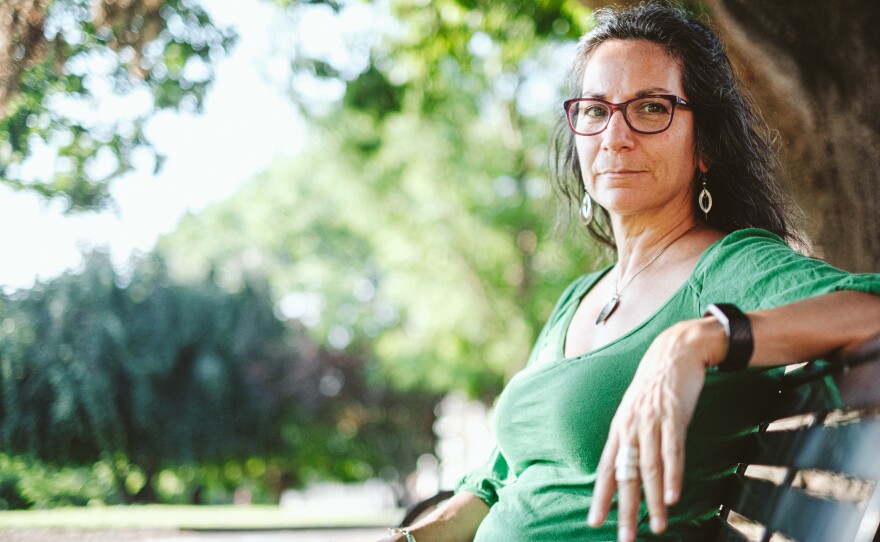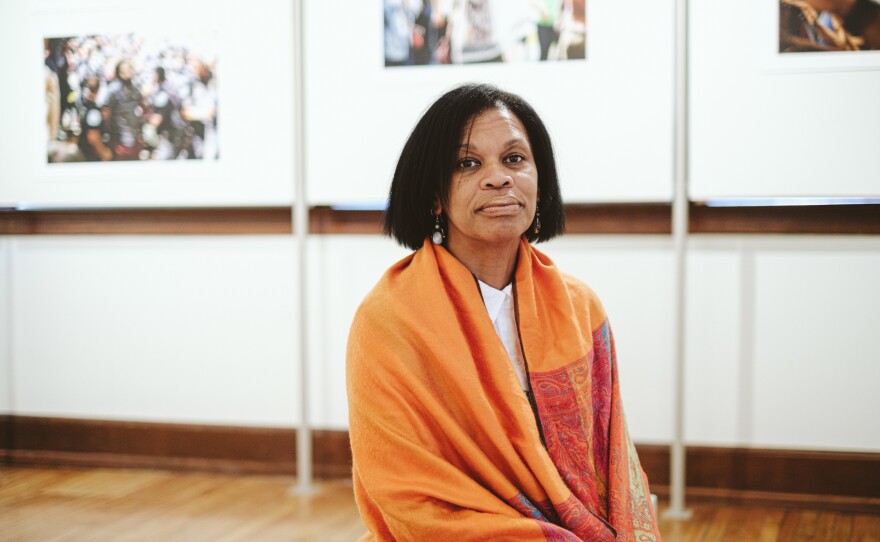CHARLOTTESVILLE, Va. — In a downtown park, grass grows over the spot where there once stood a massive bronze statue of Confederate Gen. Robert E. Lee, astride his horse Traveller.
The space feels different now, says Don Gathers, co-founder of the local Black Lives Matter group.
"It's much more serene," he says.
Gathers is in the park to reflect on five years since a violent and deadly white nationalist rally ravaged his hometown.
"It's not what you can remember. It's what you're still trying to forget," says Gathers. "All the hatefulness and the evilness that transpired here."
Organizers targeted Charlottesville for the Unite the Right rally after the city voted to take down the Lee statue, part of the town's reckoning with a fraught racial history.
On the night of Aug. 11, 2017, Neo-Nazis, Ku Klux Klansmen and other white supremacists marched through the University of Virginia campus bearing torches and terrorizing students with chants of "Blood and soil" and "Jews will not replace us."

The next day, they rallied around the Lee statue at the downtown park.
"This represents a turning point for the people of this country," then-KKK leader David Duke declared at the time. "We're going to fulfill the promises of Donald Trump because he said he's going to take our country back."
But the rally was met with resistance from hundreds of residents who rejected racism, chanting "Nazi scum off our streets."
Gathers was there and says it quickly turned violent.
"They lobbed all manner of things – rocks, soda cans filled with concrete and cement, water bottles filled with urine, tear gas and smoke grenades."
Gathers says police didn't intervene until then-Gov. Terry McAuliffe declared a state of emergency and shut down the rally.
"This is an absolute outrage," Richard Spencer, an alt-right leader and rally organizer, said at the time. "You're going to have to drag us out of here."
As demonstrators were pushed from the park, they dispersed through town, leading to pockets of violence and ultimately the deadly attack on a group of anti-racists. Neo-Nazi James Fields rammed his car into the crowd, injuring dozens of people and killing 32-year-old Heather Heyer. Two state police officers monitoring the scene died in a helicopter crash.

Charlottesville violence is seen as a catalyst
Racial justice advocates see the terror here as a turning point for the country – one that encouraged far right political violence, including the attack on the U.S. Capitol last year.
Gathers blames "continuous dog whistles" from President Trump that gave the white supremacists cover to come out of the shadows.
"They're emboldened," he says. "No one wanted to accept that or believe it as it was unfolding, but after August 11th and 12th in Charlottesville, there was January 6th."
"I think Charlottesville really was a catalyst for much of the white supremacist chaos that has ensued since," says April Muniz, who was in the crowd when the Neo-Nazi drove his car into the counter-protesters.
"What I witnessed is something that just broke me, basically," she says.
Muniz says she suffered PTSD and panic attacks and was unable to work for a time. And she grew increasingly frustrated that Fields was the only person arrested in the immediate aftermath of the Unite the Right violence.

"Everybody left town. Who's going to be held responsible?" she wondered at the time. "Because these folks that came were not immediately held accountable, they had permission to wreak havoc, and that is what they've done."
Fields was sentenced to life in prison on state murder and federal hate crime charges. When no criminal charges were brought against event organizers, some victims of the violence filed a civil lawsuit against about two dozen white nationalist leaders including Richard Spencer and Jason Kessler. A jury awarded more than $25 million in damages to the plaintiffs, among them April Muniz.
Holding organizers to account is an important step, says Ian Solomon, dean of the University of Virginia's Frank Batten School of Leadership and Public Policy. But he says it's unclear which direction the country will take.
"Are the pro-democratic forces and pro-democracy movements going to prevail or not?" asks Solomon.
He too considers events in Charlottesville a warning.
"One of the things about that weekend of 2017 was it revealed, it re-energized, it revived in many people's minds the reality that anti-democratic forces are ascendant in this country," he says. "Hate is quite brazen to show its face proudly, confidently with encouragement from elected officials."
At the time, Trump drew criticism when he condemned what he called an "egregious display of hatred, bigotry and violence on many sides," seemingly equating neo-Nazis and white nationalists to the anti-racist demonstrators.
Days later as reporters questioned his response, Trump declared that there were "very fine people on both sides."

Racial violence is part of the American fabric
Solomon says although the racial violence in Charlottesville was shocking for some, it was really a familiar refrain.
"We have a long rhythm in America of progress followed by a backsliding or backlash to that progress, so for many racial violence is nothing new," he says. "It has a long thread through American history, and yet for many it was perceived as a wake-up call."
It was certainly a wake-up call for Susan Bro, who was forced in the most painful way imaginable to understand the consequences of hate when her daughter Heather Heyer was murdered. She comes regularly to the memorial at the spot where Heather was run over, removing dead flowers and making sure the sidewalk is clear.
"To see that people still interact with this tells me that the events of the day still matter," says Bro.

She takes solace in all the messages posted on the brick walls including "Gone But Not Forgotten" and "Don't Let Hate Be Louder than Love."
Bro started an educational foundation in Heather's name and has connected with other families across the country who are victims of hate crimes. They successfully lobbied Congress to pass the Khalid Jabara and Heather Heyer NO HATE Act that was signed into law last year. It calls for stiffer penalties and provides incentives to better track hate crimes.
Bro says that's a sign of progress. But she thinks more work is needed to combat a well-organized white supremacist movement, a movement she wasn't really aware of until her daughter was murdered for standing up to it.
"The biggest lesson is none of us pay attention, including me, until it happens to you," says Bro. "As long as anybody's marginalized, as long as anybody's being mistreated, this is going to continue to happen."

Civic engagement in Charlottesville has increased in the last five years. Community activists are pressing the city on equity issues, including in housing and public schools.
One survivor of the violence, Emily Gorcenski, is tracking white supremacists and Neo-Nazis through online projects, including How Hate Sleeps.
"These projects were designed to try to help aid the understanding of how white supremacists live in our society and how they act in our society," she says.
Gorcenski, a transgender woman, was attacked during Unite the Right events in Charlottesville, and pepper sprayed by a white supremacist who later pleaded guilty to assault charges.
After a series of death threats, she moved to Germany but remains active in fighting the groups responsible for what happened in her hometown.
"There isn't awareness of the ways that these white supremacist groups recruit, attract members, share their ideology, share their messaging," she says in a Zoom interview. "That's a real problem because we can't simply eliminate the groups to solve the problem. We have to eliminate the undercurrents of white supremacy that give rise to these groups."
Transforming a Confederate statue into a more-inclusive display
Another project in Charlottesville is trying to upend the narrative around the statue of Confederate Gen. Lee. It's called Swords Into Plowshares, and is being overseen by the Jefferson School African-American Heritage Center.
"Taking something that it was harmful and then transforming it into something that is useful and of the cultural desire of the place," explains Jefferson School Director Andrea Douglas.

The city donated the statue to the Heritage Center after approving its plan to melt down the bronze and use it for a new work of public art. Two groups have filed a lawsuit trying to stop the plan. But Douglas says they're moving forward with the process of gathering public input, and in a more inclusive way.
"Before one portion of this community made decisions about what would be in our common spaces and negated the voice that, had it not been for Jim Crow, could have had a voice," Douglas says. "We are trying to return that voice."
Douglas says the idea is to create an inviting and equitable space where all of Charlottesville can interact with one another and the reworked art.
For Don Gathers, it's still hard to come to the park where Robert E. Lee stood sentry since 1924.
"It's kind of surreal because the ghost of his presence still permeates heavily in this space," says Gathers.
Much like the country, he says, it feels like there are warring spirits vying for dominance.
Copyright 2023 NPR. To see more, visit https://www.npr.org. 9(MDAzMjM2NDYzMDEyMzc1Njk5NjAxNzY3OQ001))







